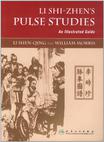李时珍脉象图谱
2011-3
人民卫生出版社
李申清
170
This book is for educational and reference purposes only. In view of the possibility of human erroror c.hanges in medical science, the author, editor, publisher, and any other party involved in thepublication of this work do not guarantee that the information contained herein is in any respectaccurate or complete. The medicinal therapies and treatment techniques presented in this bookare provided for the purpose of reference only. If readers wish to attempt any of the tectmiques orutilize any of the medicinal therapies contained in this book, the publisher assumes no responsibilityfor any such actions. It is the responsibility of the readers to understand and adhere to local lawsand regulations concerning the practice of these techniques and methods. The authors, editors,and publisher disclaim all responsibility for any liability, loss, injury, or damage incurred as aconsequence, directly or indirectly, of the use and application of any of the contents of this book.
李申清,Li Shen-qing was born in Hubei Province, China, in 1952. His path toward becoming a Chinesemedical practitioner had striking parallels to his predecessor, Li Shi-zhen.Li Shen-qing's grandfather was a well-known practitioner of Chinese medicine who passedaway in the 1940s leaving his family with an extensive library ofpre-modern medical books.These treasures provided the basis for much of Shen-qing's medical knowledge. Access toboth family lineage and textual resources placed Li Shen-qing into a unique position thatenabled him to gain mastery of pulse diagnosis.Li Shen-qing's papers have been published in the Chinese Medicine Journal, Forum ofWorld's Renowned Physicians, Selected Medical Papers of China, Selected ContemporaryMedical Papers of China, and international medical journals. He has books published byAncient Chinese Medicine Books Publishing House and he has an extensive publishingrecord with People's Medicine Publishing House.Li has a unique approach to clinical practice that combines Li Shi-zhen style pulse diagnosiswith tuina. During his illustrious career, Shen-qing designed advanced tui na curriculum forBeijing University of Chinese Medicine. Shen-qing's work successfully fills in the missingpieces of Chinese tui na textbooks according to the Secretary-General of China's MassageExperts Committee, Professor Wang Guo-shun. These works were published by PMPH inChinese, English, German, French, and Spanish. Shen-qing also edited Guidelines to theStudy of Massage Points, now a textbook published by Science Publishing House.After gaining recognition as a medical practitioner, Shen-qing focused in statistics. He thenapplied statistical models to the systematic study of pulse diagnosis literature attributed to LiShi-zhen. These studies form the basis of the graphic representations in this book.Li Shen-qing is the essence of humility, charm, warmth, care, and knowledge. Li Shen-qinghas deep respect for the shared home province with Li Shi-zhen. The ability to carry on LiShi-zhen's study of pulse diagnosis and share it internationally is also a great privilege. Hispragmatic world view is summed in his motto, to "simplify the complicated issues, and makethe simple issues practical."
About Li Shi-zhenAbout the AuthorsAcknowledgementsPrefaceHow to Read the Pulse IllustrationsCHAPTER 1 History of Chinese Pulse StudiesCHAPTER 2 Introduction to Pulse DiagnosisCHAPTER 3 Pulse ImagesCHAPTER 4 ComparisonsCHAPTER 5 Concurrent Pulses and Associated DiseasesCI1APTER 6 The Pulse MonographsCHAPTER 7 Pulse Diagnostic Case RecordsAPPENDIXESAppendix 1 Pulse Map ComparisonsAppendix 2 ArrhythmiaAppendix 3 Strange PulsesAppendix 4 Classic and Modern Books-Listed AlphabeticallyAppendix 5 Points, Formulas, and MedicinalsIndexPulse Nomenclature Comparison Table
Uncertainty and complexity shadow the practice of pulse diagnosis. There is no mystery,however, for the diligent. Palpation of the pulse provides direct contact with the blood andthe vessels, which are the rivers of life. It is a non-verbal form of communication wheredeeper knowledge and understanding is revealed. It is a path with heart that connects thepatient and physician. Theoretical and practical knowledge of pulse images are required in order to penetratethese mysteries. Once the ability to describe, compare, contrast, and identify the pulses isachieved, the secrets of direct knowledge are revealed through practice.Knowledge gained through the pulse allows for greater dimensions of sense and sensitivitythan from dialog alone. Extending beyond the four diagnostic pillars of palpation,observation, inquiry, and olfaction are the practitioner's impressions, bodily sensations,internal images, and emotions. Such qualitative and subjective knowledge is precious andmust be tempered by consideration for a confluence of signs and symptoms with the rational discipline of Chinese medicine.This chapter establishes the basics and provides background information on the practice ofpulse diagnosis. The purpose is to provide an overview and some explanation about the theory and practice of pulse diagnosis. ……
